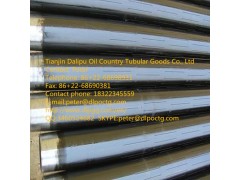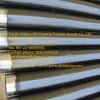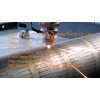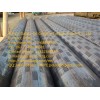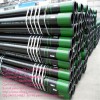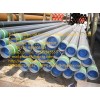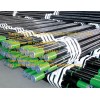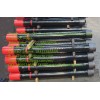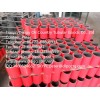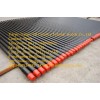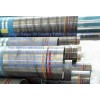Slotted liners are made from tubulars by saw-cutting slot configurations, as shown in the drawing, Slot widths are often referred to in terms of gauge. Slot or screen gauge is simply the width of the opening in inches multiplied by 1,000. For instance, a 12-gauge screen has openings of 0.012 in.
The machining consists of cutting rectangular openings with small rotary saws. Routine slot widths are 0.030 in. or larger. The minimum slot width that can be achieved is about 0.012 in. Slots that cut less than 0.020 in. in width involve high costs because of excessive machine downtime to replac broken saw blades that overheat, warp, and break.
The single-slot staggered, longitudinal pattern is generally preferred because the strength of the unslotted pipe is preserved. The staggered pattern also gives a more uniform distribution of slots over the surface area of the pipe. The single-slot staggered pattern is slotted with an even number of rows around the pipe with a typical 6-in. longitudinal spacing of slot rows.
SPECIFICATIONS:
|
API Standard Casing |
ID |
Length |
Slot |
Slot No. |
Slot |
Slot |
Valid |
Stength |
||
|
Spec. |
Thickness |
Weight |
||||||||
|
60.32 |
5 |
6.84 |
50.3 |
3 |
80 |
200 |
0.3 |
±50 |
48 |
512.54 |
|
73.02 |
5.5 |
9.15 |
62 |
3 |
80 |
240 |
0.3 |
±50 |
57.6 |
688.55 |
|
88.9 |
6.5 |
13.22 |
75.9 |
3 |
80 |
280 |
0.3 |
±50 |
67.2 |
995.1 |
|
101.6 |
6.5 |
15.22 |
88.6 |
3 |
80 |
300 |
0.3 |
±50 |
72 |
1151.2 |
|
114.3 |
7 |
18.47 |
100.3 |
10 |
80 |
320 |
0.3 |
±50 |
76.8 |
1400.4 |
|
127 |
7.52 |
22.13 |
112 |
10 |
80 |
340 |
0.3 |
±50 |
81.6 |
1673.8 |
|
139.7 |
7.72 |
25.11 |
124.3 |
10 |
80 |
360 |
0.3 |
±50 |
86.4 |
1900.2 |
|
139.7 |
9.17 |
29.48 |
121.4 |
10 |
80 |
360 |
0.3 |
±50 |
86.4 |
2232.4 |
|
168.3 |
8.94 |
35.09 |
150.4 |
10 |
80 |
400 |
0.3 |
±50 |
96 |
2672.95 |
|
177.8 |
8.05 |
33.68 |
161.7 |
10 |
80 |
440 |
0.3 |
±50 |
105.6 |
2559.2 |
|
177.8 |
9.19 |
38.19 |
159.4 |
10 |
80 |
440 |
0.3 |
±50 |
105.6 |
2940.7 |
The slots can be straight or keystone shaped. The keystone slot is narrower on the outside surface of the pipe than on the inside. Slots formed in this way have an inverted “V” cross-sectional area and are less prone to plugging because any particle passing through the slot at the outside diameter (OD) of the pipe will continue to flow through, rather than lodging within the slot. While the slotted liners are usually less costly than wire-wrapped screens, they have smaller inflow areas and experience higher pressure drops during production. Slotted liners also plug more readily than screens; they are used where well productivity is small and economics cannot support the use of screens.
The length of the individual slots is measured on the inside diameter (ID) of the pipe. Usual practice dictates 1½-in. long slots for slot widths of 0.030 in. and under, 2-in. long slots for slot widths between 0.030 to 0.060 in., and 2½-in. long slots for slot widths of 0.060 in. and larger. Slot width tolerance is generally ± 0.003 in. for widths of 0.040 in. and wider and ± 0.002 in. for widths less than 0.040 in.
The primary advantage of a slotted liner over wire-wrapped screens is usually cost; however, small gauge, high-density slot patterns may cost as much as wire-wrapped screens. The disadvantages of the slotted liner are:
limited flow area (2 to 3%, creating a low tolerance to plugging)
minimum available slot size (approximately 0.012 in.).
Slot widths that are less than 0.020 in. and cut in standard carbon steel-pipe grades can rust and will either close or reconfigure the slot opening so that they do not function properly unless they are coated, protected, or stored indoors before use.

